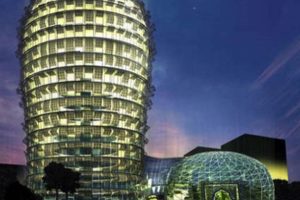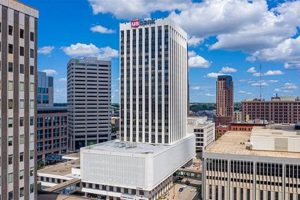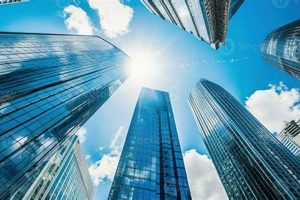Skyscraper windows are architectural marvels that provide natural light and ventilation to high-rise buildings while withstanding tremendous forces like wind pressure and seismic activity. These windows are meticulously engineered to ensure occupant comfort, energy efficiency, and structural integrity, making them a crucial element in the design of modern skyscrapers.
Skyscraper windows have evolved significantly over time, from the single-pane windows of early skyscrapers to the advanced double- and triple-glazed systems used today. These systems incorporate innovative technologies like low-emissivity coatings, reflective films, and insulating gases to enhance energy efficiency and reduce heat transfer. Additionally, advances in glass manufacturing techniques have led to the development of stronger, lighter, and more transparent glass, enabling the creation of expansive window walls that maximize natural light and offer breathtaking views.
Skyscraper windows play a vital role in the overall sustainability of high-rise buildings. By reducing heat gain and loss, they contribute to energy savings and lower carbon emissions. Moreover, they enhance occupant well-being by providing natural light, which has been shown to improve mood, productivity, and sleep quality. Furthermore, the sound insulation properties of modern skyscraper windows help mitigate noise pollution, creating a more comfortable and peaceful indoor environment.
1. Transparency
The transparency of skyscraper windows is a crucial factor in maximizing natural light within high-rise buildings. Natural light has numerous benefits for occupants, including improved mood, increased productivity, and enhanced sleep quality. Moreover, it reduces the need for artificial lighting, leading to energy savings and a more sustainable building operation.
The large surface area of skyscraper windows allows ample daylight to penetrate deep into the building’s interior, creating a sense of spaciousness and openness. This is particularly important in densely populated urban areas where access to natural light can be limited. The transparency of windows also provides panoramic views of the surrounding cityscape, offering a connection to the outdoors and reducing feelings of confinement.
Incorporating transparency into skyscraper windows requires careful consideration of factors such as solar heat gain and glare. Advanced glazing technologies, such as low-emissivity coatings and reflective films, can be utilized to control the amount of solar radiation entering the building while maintaining transparency. This ensures occupant comfort and minimizes the need for additional shading devices or artificial cooling systems.
Overall, the transparency of skyscraper windows plays a vital role in creating a comfortable, energy-efficient, and visually appealing indoor environment. By allowing natural light to flood interiors, these windows contribute to the overall well-being of occupants and the sustainability of the building.
2. Energy efficiency
In the context of skyscraper windows, energy efficiency is paramount due to the significant energy consumption associated with heating and cooling high-rise buildings. Advanced glazing technologies play a crucial role in minimizing heat gain and loss, leading to lower energy consumption and reduced carbon emissions.
One key technology is low-emissivity (low-e) coatings, which are applied to the glass surface to reflect long-wave infrared radiation (heat) back into the building during winter and reflect short-wave solar radiation (heat) away from the building during summer. This helps maintain a comfortable indoor temperature while reducing the need for heating and cooling systems.
Another important technology is double- or triple-glazed windows, which consist of multiple layers of glass separated by an insulating gas, such as argon or krypton. These systems provide excellent thermal insulation, reducing heat transfer between the interior and exterior of the building. Additionally, the use of reflective films can further enhance solar control, reducing glare and heat gain while maintaining transparency.
The implementation of these advanced glazing technologies in skyscraper windows has a direct impact on the energy efficiency of the building. Studies have shown that buildings with energy-efficient windows can achieve significant energy savings, ranging from 10% to 30%. This translates into lower operating costs, reduced carbon footprint, and a more sustainable building operation.
In conclusion, the integration of advanced glazing technologies into skyscraper windows is essential for achieving energy efficiency and reducing the environmental impact of high-rise buildings. These technologies minimize heat gain and loss, leading to lower energy consumption, cost savings, and a more sustainable built environment.
3. Structural integrity
In the context of skyscraper windows, structural integrity is of utmost importance. High-rise buildings are subjected to extreme wind loads and seismic forces, and the windows must be engineered to withstand these forces without compromising the safety and stability of the building.
- Wind resistance: Skyscraper windows are designed to resist high wind loads, which can cause the building to sway and potentially lead to structural damage. Advanced engineering techniques, such as the use of reinforced frames and laminated glass, ensure that the windows can withstand these forces and maintain their integrity.
- Seismic resilience: In earthquake-prone areas, skyscraper windows must be able to withstand seismic activity. This involves designing windows that can accommodate the building’s movement during an earthquake without shattering or causing injury to occupants. Seismic-resistant glazing systems, such as those incorporating flexible gaskets and break-resistant glass, are used to achieve this.
- Impact resistance: Skyscraper windows may also need to be designed to resist impact from objects, such as debris or even accidental collisions. Impact-resistant glass, which is made of laminated or tempered glass, can withstand significant force without shattering or breaking into dangerous shards.
- Fire resistance: In the event of a fire, skyscraper windows must be able to resist the spread of flames and smoke. Fire-resistant glazing systems, which incorporate intumescent materials that expand and seal gaps in the event of a fire, are used to prevent the spread of fire and protect occupants.
By ensuring the structural integrity of skyscraper windows, architects and engineers can create high-rise bu
ildings that are safe, stable, and resilient in the face of various environmental and structural challenges.
4. Aesthetics
When it comes to skyscraper windows, aesthetics play a significant role in complementing the architectural design of the building and enhancing its overall appearance. The thoughtful integration of windows can elevate the visual appeal of a skyscraper, making it an iconic landmark and a harmonious addition to the urban landscape.
- Facade Design: Skyscraper windows are often used as a key design element in the facade of the building. Their size, shape, and arrangement can create a striking visual effect, influencing the overall character of the skyscraper. For instance, floor-to-ceiling windows can give a building a sleek and modern appearance, while smaller, regularly spaced windows can evoke a more traditional aesthetic.
- Natural Light and Transparency: The use of large windows allows for ample natural light to enter the building, creating a bright and airy interior environment. This not only enhances the occupants’ well-being but also reduces the need for artificial lighting, contributing to the building’s sustainability.
- Views and Connection to the Outdoors: Skyscraper windows offer occupants stunning views of the surrounding cityscape, nature, or distant landmarks. This connection to the outdoors can reduce stress, improve mood, and boost creativity among the building’s occupants.
- Architectural Expression: Windows can be used to express the architect’s creative vision and convey a specific design concept. For example, the use of curved or irregularly shaped windows can create a dynamic and visually appealing exterior, distinguishing the building from its surroundings.
In conclusion, the aesthetic considerations of skyscraper windows extend beyond mere functionality. They contribute to the building’s overall design, enhance the well-being of occupants, and create a striking visual impact on the urban environment. By carefully integrating aesthetics into the design of skyscraper windows, architects can transform high-rise buildings into architectural masterpieces that inspire and elevate the surrounding community.
5. Sustainability
In the context of skyscraper windows, sustainability is a crucial aspect that contributes to the environmental friendliness and long-term viability of high-rise buildings. By incorporating energy-efficient and low-carbon design principles into skyscraper windows, architects and engineers can significantly reduce the environmental impact of these structures.
- Energy Efficiency: Skyscraper windows play a vital role in regulating the building’s energy consumption. Advanced glazing technologies, such as low-emissivity coatings and double- or triple-glazed systems, minimize heat gain and loss, reducing the need for heating and cooling systems. This leads to substantial energy savings and lower greenhouse gas emissions.
- Natural Ventilation: Well-designed skyscraper windows can facilitate natural ventilation, reducing the reliance on mechanical ventilation systems. Operable windows allow for fresh air to circulate throughout the building, improving indoor air quality and thermal comfort while reducing energy consumption.
- Daylighting: Large windows allow natural light to penetrate deep into the building, reducing the need for artificial lighting during daytime hours. This not only saves energy but also enhances occupant well-being by providing access to natural daylight.
- Recyclable Materials: Utilizing recyclable materials in the construction of skyscraper windows, such as aluminum frames and glass, contributes to a more sustainable and circular economy. These materials can be recycled and reused at the end of the building’s life cycle, minimizing waste and conserving natural resources.
By embracing sustainability in the design and construction of skyscraper windows, architects and engineers can create energy-efficient, low-carbon buildings that contribute to a greener and more sustainable built environment.
6. Occupant well-being
Skyscraper windows play a pivotal role in enhancing occupant well-being by providing access to natural light. Natural light has been scientifically proven to have a profound impact on human health and cognitive function.
Exposure to natural light during the day helps regulate the body’s circadian rhythm, which is responsible for sleep-wake cycles. Studies have shown that people who work or live in spaces with ample natural light tend to have better sleep quality, reduced stress levels, and improved mood. Natural light has also been linked to increased productivity and cognitive performance.
In the context of skyscraper design, large windows allow for maximum natural light penetration, creating brighter and more inviting indoor environments. This is especially important in high-rise buildings, where occupants may spend extended periods indoors with limited access to outdoor spaces. By providing access to natural light, skyscraper windows contribute to the overall health and well-being of occupants, fostering a more comfortable and productive indoor environment.
Several notable examples showcase the positive impact of skyscraper windows on occupant well-being. The WELL Building Standard, a leading certification for healthy buildings, places a strong emphasis on natural light as a key factor in creating spaces that promote occupant health and productivity. Many LEED-certified green buildings also incorporate large windows to maximize natural light and improve indoor environmental quality.
In conclusion, the connection between skyscraper windows and occupant well-being is undeniable. By providing access to natural light, skyscraper windows help regulate circadian rhythms, improve mood and sleep quality, and enhance cognitive function. This understanding is essential for architects and designers to consider when creating high-rise buildings that prioritize the health and well-being of their occupants.
7. Innovation
In the realm of skyscraper windows, innovation plays a pivotal role in pushing the boundaries of design and performance. Continuous advancements in glass manufacturing and window design have unlocked new possibilities, transforming the way we experience and interact with high-rise buildings.
- Advanced Glass Technologies: The advent of advanced glass technologies, such as low-emissivity coatings and laminated glass, has significantly improved the energy efficiency and safety of skyscraper windows. These technologies minimize heat loss and gain, reducing energy consumption and enhancing occupant comfort. Laminated glass, composed of multiple layers of glass bonded together with an interlayer, provides exceptional strength and impact resistance, ensuring the safety of occupants in the event of breakage.
Oversized and Custom-Shaped Windows: Technological advancements have made it possible to manufacture oversized and custom-shaped windows, offering architects and designers greater flexibility in creating unique and visually striking facades. These windows, often spanning multiple floors, provide panoramic views and allow for abundant natural light to flood into interior spaces. Custom-shaped windows, tailored to specific design concepts, add an element of artistic expression and individuality to skyscraper architecture. - Smart Windows: The integration of smart technologies into skyscraper windows has opened up new avenues for energy efficiency and occupant comfort. Smart windows can automatically adjust their tint or opacity in response to changing environmental conditions, optimizing natural light while reducing glare and heat gain. They can also be integrated with building management systems, allowing for remote monitoring and control, further enhancing energy efficiency and occupant well-being.
- Sustainable Materials: Innovation in glass manufacturing has also focused on sustainability. The use of recycled materials and eco-friendly production processes has reduced the environmental impact of skyscraper windows. Recycled glass can be incorporated into new windowpanes, conserving natural resources and reducing waste. Additionally, the development of bio-based materials, derived from renewable sources, offers sustainable alternatives to traditional window components.
These advancements in glass manufacturing and window design have revolutionized the design and performance of skyscraper windows, contributing to energy efficiency, occupant comfort, and architectural expression. As innovation continues to drive progress in this field, we can expect even more groundbreaking developments that will shape the future of skyscraper design and construction.
FAQs on Skyscraper Windows
Skyscraper windows play a vital role in the design, construction, and sustainability of high-rise buildings. Here are answers to some frequently asked questions regarding skyscraper windows:
Question 1: How do skyscraper windows withstand strong winds and seismic activity?
Skyscraper windows are engineered to withstand extreme wind loads and seismic forces. They incorporate reinforced frames, laminated glass, and advanced glazing systems that can resist high pressures and vibrations. These design features ensure the structural integrity of the building and the safety of its occupants.
Question 2: How do skyscraper windows contribute to energy efficiency?
Skyscraper windows play a crucial role in enhancing the energy efficiency of high-rise buildings. Advanced glazing technologies, such as low-emissivity coatings and double- or triple-glazed systems, minimize heat gain and loss. This reduces the energy consumption associated with heating and cooling, leading to lower operating costs and a reduced carbon footprint.
Question 3: How do skyscraper windows impact occupant well-being?
Skyscraper windows provide occupants with access to natural light, which has numerous benefits for well-being. Natural light regulates circadian rhythms, improving sleep quality and mood. It also reduces stress levels, enhances cognitive function, and creates a more comfortable and inviting indoor environment.
Question 4: Are skyscraper windows designed to be sustainable?
Sustainability is a key consideration in the design of skyscraper windows. Advanced glazing technologies, such as low-emissivity coatings, help reduce energy consumption and carbon emissions. Additionally, the use of recycled materials and eco-friendly production processes minimizes the environmental impact of skyscraper windows.
Question 5: How do skyscraper windows contribute to a building’s aesthetics?
Skyscraper windows are not only functional but also contribute to the overall aesthetics of a building. Their size, shape, and arrangement can create striking visual effects and enhance the architectural expression of the building. Large windows provide panoramic views, connecting occupants to the surrounding cityscape and nature.
Question 6: What innovations are shaping the future of skyscraper windows?
Continuous advancements in glass manufacturing and window design are leading to new possibilities for skyscraper windows. Smart windows can automatically adjust their tint or opacity, optimizing natural light while reducing glare and heat gain. Oversized and custom-shaped windows offer greater design flexibility and allow for unique architectural expressions.
In summary, skyscraper windows are complex and multifaceted architectural elements that contribute to the structural integrity, energy efficiency, occupant well-being, sustainability, aesthetics, and innovation of high-rise buildings.
By addressing these FAQs, we hope to provide a deeper understanding of the importance and advancements of skyscraper windows in contemporary architecture.
Skyscraper Windows
Skyscraper windows are crucial elements in the design and construction of high-rise buildings. Here are some tips for their effective implementation:
Tip 1: Prioritize Energy Efficiency: Utilize advanced glazing technologies, such as low-emissivity coatings and double- or triple-glazed systems, to minimize heat gain and loss. This reduces energy consumption, lowers operating costs, and contributes to a greener building.
Tip 2: Optimize Natural Light: Design windows to maximize natural light penetration, reducing the need for artificial lighting during daytime hours. This enhances occupant well-being, improves mood, and reduces energy consumption.
Tip 3: Ensure Structural Integrity: Engineer windows to withstand high wind loads and seismic forces. Utilize reinforced frames, laminated glass, and advanced glazing systems to maintain the structural stability of the building and ensure occupant safety.
Tip 4: Consider Aesthetics: Integrate windows into the overall architectural design to enhance the building’s aesthetics. Explore different sizes, shapes, and arrangements to create visually striking facades and complement the surrounding environment.
Tip 5: Embrace Innovation: Stay updated with advancements in glass manufacturing and window design. Implement smart windows that adjust their tint or opacity, oversized windows for panoramic views, and sustainable materials for a reduced environmental impact.
Tip 6: Collaborate with Experts: Engage with architects, engineers, and glazing contractors who specialize in skyscraper windows. Their expertise ensures optimal design, installation, and maintenance, leading to long-lasting performance and occupant satisfaction.
By following these tips, architects and building owners can effectively design and implement skyscraper windows that enhance energy efficiency, occupant well-being, structural integrity, aesthetics, and sustainability.
Skyscraper Windows
Throughout this exploration, we have delved into the world of skyscraper windows, uncovering their multifaceted significance in high-rise architecture. From their role in energy efficiency and occupant well-being to their contribution to structural integrity and aesthetic appeal, skyscraper windows stand as a testament to the ingenuity and innovation that drive modern construction.
As we look towards the future of skyscraper design, it is evident that the evolution of skyscraper windows will continue to play a pivotal role. With advancements in glass manufacturing and window design, we can expect even more groundbreaking developments that push the boundaries of perfor
mance and sustainability. These innovations will not only enhance the functionality and aesthetics of high-rise buildings but also contribute to a more sustainable and occupant-centric built environment.







